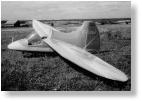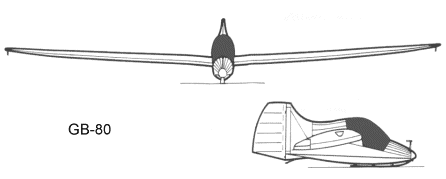| http://www.survol.cjb.net |
Briffaud GB-6 / GB-80 "Aérovoilier"
 |
 |
 |
| GB-6 before its first fligth |
GB-80 on ground | |
 |
 |
|
| GB-80 in flight | GB-9 under construction | |
| (click on the pictures to enlarge them in a new window) | ||
In the Fifties, Georges Briffaud designed the GB-6, a tailless airplane with a high wing and a Lutétia 44 hp engine. Inspired by the work of Abrial and Fauvel, he provided his airplane with an inherently stable wing allowing the horizontal tail to be omitted. The wing, however, had an original airfoil section, based on the NACA 23012, whose inherent stability was achieved by raising the trailing edge. Assembled by SAN (Société Aéronautique Normande), this airplane took off with Lucien Quérey (Director of SAN) at the controls in June 1955, from the Bernay airport. While landing on a wet section of the runway, however, the nosewheel dug in and the GB-6 flipped over violently. The pilot was only slightly injured.
Only the wing was salvageable. Georges Briffaud considered re-using it by enlarging it for use in a motorglider project, the GB-80. This was a midwing single-seater whose engine, placed near the center of gravity, was to drive via a short driveshaft a two-bladed propeller located between the fixed vertical fin and the rudder (a solution also employed by the Fisher-Boretzki "Fibo 2a" (1952) and Rhein Flugzeugbau RW-3 (1955) motorgliders). This solution had the advantage of fairing in the propeller during soaring flight without requiring feathering or the retraction of the engine-propeller assembly. The airframe was of fabric-covered wood; the cockpit was equipped with a molded canopy.
The GB-80 made its first flight as a glider on 21 September 1960 at Beynes with pilot Jacques Gomy at the controls, pulled by the club towplane. During succeeding flights, several modifications proved necessary, notably an increase in rudder area. Handling of the GB-80 was similar to that of other gliders of the same generation, and the machine's wing performance was close to that of the Nord 2000 (French version of the German "Meise"), despite a low aspect ratio of only 7.6. It received its certificate of airworthiness (CNRP) on 4 July 1961. On one flight, it was double-towed with another flying wing, the AV-36 flown by Eric Nessler.
The motor originally intended for it, a 2-stroke, 18 hp Kroeber, was never installed, being replaced by an equivalent weight of ballast. The engine had no starter, and the development of that accessory was never completed (Charles Fauvel faced similar problems with the AV-45). Georges Briffaud designed a version designated GB-81, with a new, easier to build fuselage, but that project was never realized. Disappointed, Georges Briffaud decided in 1963 to dismantle the GB-80 (a decision that he later regretted !). In 1965, he threw himself into the design of the GB-9, a motorglider, this time with the engine in front. Although well advanced, construction was never completed, Georges Briffaud being very busy with his professional work at CEA (the French atomic energy commission). Later, with his son, he built the GB-10 "Pou-push" based on the Mignet design formula, and the ultralight GB-11.
Translated from the French by Marc de Piolenc (piolenc@reporters.net).
| Characteristics and performance of the GB-80 | |
| Wing span | 11.20 m |
| Length | 4.20 m |
| Wing Area | 15.4 m2 |
| Airfoil | modified NACA 23012 |
| Aspect ratio | 7.6 |
| Empty weight | 165 kg |
| Max. weight | 260 kg |
| Best glide ratio | 22:1 |
| Minimum sink rate | 0.90 m/s |
